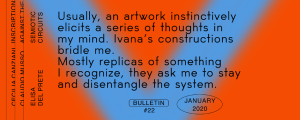Hard Rock Life: Llyn Foulkes at Andrea Rosen Gallery
Forget what you think you know about landscapes and postcards, and consider Llyn Foulkes. The artist’s landscape works from 1963 to 1984 are explored in a new exhibition at Andrea Rosen Gallery. On display is Foulkes’ signature rag technique; he carefully distributes paint onto the canvas with a rag, revealing complex textures.
Foulkes is a Los Angeles based multimedia artist, performance artist, and musician. His works are typically described as Surrealist and Dadaist but with a pop-culture twist, as he’s prone to including Mickey Mouse in some of his paintings. The accomplished 79-year-old artist is being recognized in a travelling retrospective which began at the Hammer Museum, and is currently on view at the New Museum, followed by the Museum Kurhaus Kleve in December.
Unlike the retrospective featuring nearly 150 of Foulkes’ works, this exhibition is comprised of only six and is held at Andrea Rosen Gallery 2—it opened adjacent to their main gallery in Fall 2012. The intimate space allows the viewer to focus closely on the richness of each work, several of whom are comparative in scale to that of actual postcards.

Installation view: Llyn Foulkes, Andrea Rosen Gallery 2, New York, October 12 – November 16, 2013
Photograph taken by Lance Brewer, courtesy of Andrea Rosen Gallery
Foulkes, who has once described Los Angeles as “lost frontier,” injects the feeling of vintage Americana into his works. The work Esther, Maiden of Mesa Verde is an oil and acrylic on photo collage that contains a handwritten postcard addressed to Foulkes’ Highland Park address, featuring a photograph of a rock formation seemingly layered atop the postcard of what is likely one of the Colorado boulders. The title references the famous “smiling mummy” nicknamed Esther who was found in a Colorado town near Mesa Verde and was once on display at the Mesa Verde National Park Museum until the late 1970s. (The Native American Graves Protection and Repatriation Act of 1990 was passed for the repatriation of Native American human remains and sacred objects.) Esther alludes to a cultural history impacted, and likely forgotten, by contemporary society. Similarly, Foulkes’ works remind us of a once popular way in which people experienced America’s territories and shared the experience with others.

Llyn Foulkes Esther, Maiden of Mesa Verde , 1974, oil and acrylic on photograph with collage
© Llyn Foulkes, photograph taken by Lance Brewer, courtesy of Andrea Rosen Gallery
The Splash engages the viewer with visible textures of dark paint on canvas juxtaposed a flat blue sky background with a white swirl of color, perhaps alluding a to “splash” of color. His rag technique lends a multi-dimensionality and abstraction to the work, (a portion of the paint actually continues onto the frame) as well as a nod to real mountain ranges. (On a similar note, Josh Smith’s palette paintings come to mind.)

Llyn Foulkes, The Splash, 1984, mixed media
© Llyn Foulkes, photograph taken by Lance Brewer, courtesy of Andrea Rosen Gallery
Foulkes’ works are a constant reminder of the significant impact experimentation and innovation have on the manner in which we view our reality. His use of everyday materials recreate the American landscape with a deep sense of nostalgia and anxiety over a lost era.
Llyn Foulkes at Andrea Rosen Gallery, New York, through November 16, 2013
by Kuoure Thomas
in Focus on the American East
Nov 12, 2013






















